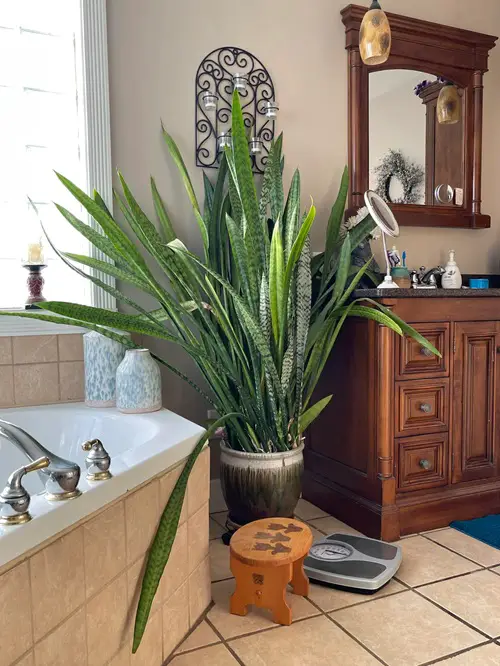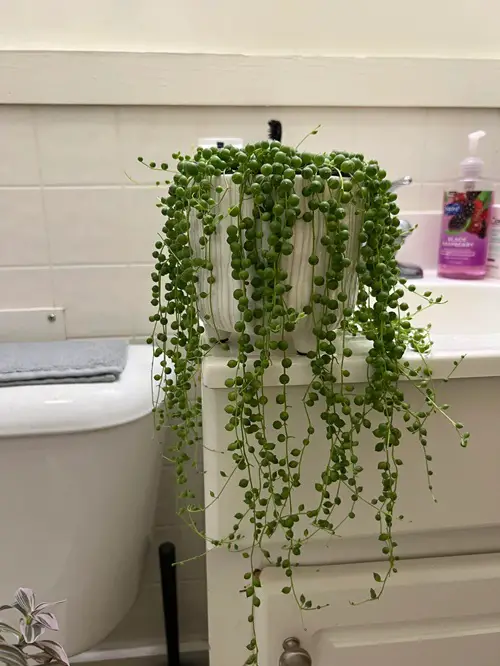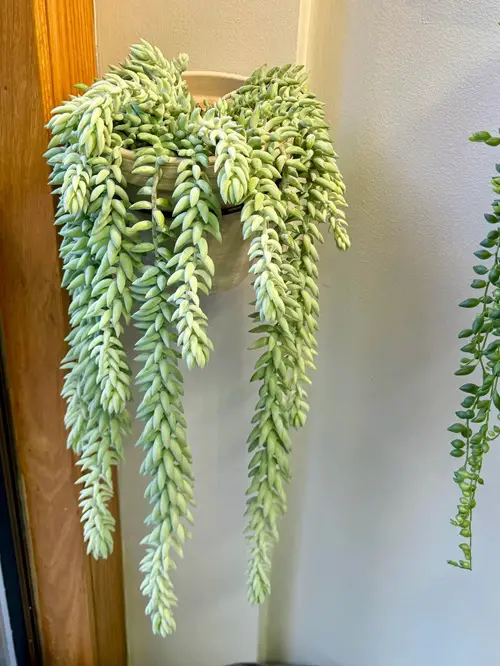Yes, these drought-tolerant plants thrive in dry conditions! But there are some succulents you can grow in the Bathroom, too—Read on!
Succulents are hardy plants that can survive the harshest of conditions including temperature fluctuations, poor soil, and humidity. These qualities can be capitalized upon by creative plant enthusiasts who choose to add a bit of greenery to their bathrooms. So if you too want a botanical bathing companion here are the succulents to go to!
Succulents You Can Grow in The Bathroom
1. Aloe Vera
Botanical Name: Aloe barbadensis Mill
Aloe vera needs no introduction as it is one of the most famous succulents. It is easily recognized by its long, somewhat triangular, spiky leaves that are filled with gel. But did you know that these plants love humidity? Bathroom conditions are perfect for their growth, and they can also grow in indirect sunlight, which can be fulfilled by a bathroom window or exhaust vent.
If you choose to grow one of these yourself, try placing it near a bright window and watering it sparingly directly into a well-draining potting mix. Over time, excess humidity can lead to health deterioration, so it must be periodically moved to a dry and sunny spot.
Tip: The gel inside aloe vera leaves can be used for soothing burns, skincare, or hair care. Always keep one handy in your bathroom!
2. Snake Plant
Botanical Name: Sansevieria trifasciata
Straight from South Africa, the Snake Plant can also call your bathroom its home if provided with the correct conditions. This plant with upright, sword-like dark green leaves (with patterns) doesn’t mind low light and humid conditions—hence, it is often used to decorate kitchens and bathrooms.
Almost all snake plant varieties are popular for filtering out toxins and being hard to kill, so that is a bonus of growing it in your bathroom. Just ensure that it is provided with at least low light and infrequent watering.
3. Ox Tongue

Botanical Name: Gasteria gracilis
If you don’t have the time or energy to constantly care for your bathroom succulent, the Ox tongue will be a blessing. This plant grows at a very slow pace and requires almost no babysitting. It is so low-light tolerant that it can even survive in windowless bathrooms.
Gasteria gracilis can be identified by its small, flat yet fleshy green leaves with grey or white dots. Choosing a pot with multiple holes for excellent drainage is of utmost importance while growing this plant.
4. String of Pearls
Botanical Name: Senecio rowleyanus
String of Pearls is a plant that can survive in both extremes—the arid weather of deserts or the humid conditions of one’s bathroom. These moisture-resistant plants have trailing vines adorned with bead-like fleshy leaves that can add a cascading botanical look to your bathroom.
This plant is not very picky about its location as long as it receives adequate bright indirect sunlight and is planted in a potting mix made with sand or perlite.
Tip: Keep the pearls dry when watering to avoid fungal issues. Trimming the vines regularly will encourage dense growth.
5. Panda Plant
Botanical Name: Kalanchoe tomentosa
There are few plants more adorable and apt as bathroom buddies as the Panda Plant due to its soft, furry leaves with brownish edges. This plant remains quite small and hence is perfect for compact restrooms. There are many different varieties of this plant each looking better than the last, so you can choose the one that catches your eye.
Remember that this plant’s leaves have fine hairs that can trap water and lead to fungal diseases. Avoid direct contact with the leaves while watering or doing any other activity in the bathroom. Plus, place it where water splashes won’t reach it to keep the furry leaves healthy.
6. Echeveria
Botanical Name: Echeveria gibbiflora
With their rosettes of fleshy green leaves edged with hot pink, echeverias add color to bathing spots. Echeverias are in the same family as sedums, jade trees, and kalanchoes and share many physical traits.
These plants do well in pots in front of sunny windowsills and squeeze into tight spaces due to their miniature size. Also, they require little watering making it perfect for forgetful gardeners.
7. Burro’s Tail
Botanical Name: Sedum morganianum
Mimicking the textured look of a Burro’s Tail, this plant is rightfully named so. But did you know that this cascading succulent plant can survive in humid environments? The Burro’s Tail, also popular as Donkey’s Tail, can be used to beautify bathrooms with its long stems covered with fleshy triangular leaves.
You can uniquely display it in hanging baskets as the stems droop over the edge. In fact, it is recommended to use a location with low foot traffic, as the plant is sensitive to touch.
8. Haworthia
Botanical Name: Haworthia
If you want a semi-transparent succulent that keeps you under the shower for a few extra minutes to admire its beauty, Haworthia is the plant for the job! This plant forms compact clumps, and its crystal-like appearance makes it a much-desired plant.
Haworthias have translucent leaves that avoid sunburn and allow for minimum water loss. This allows them to grow in low-light environments. They can also be plant in dishes or terrariums to increase the wow factor in your bathroom.
9. Peperomia

Botanical Name: Peperomia
Peperomia, also known as the radiator plant, partially belongs on this list as it displays semi-succulent-like properties. It is native to the tropical rainforests of the Americas, Africa, and parts of Asia and Australia. In their natural environment, the humidity is high all year long, and hence, these plants have evolved to thrive in moist and warm conditions.
This is why these compact, round, or heart-shaped leafed plants do well in bathrooms. Also, they do not mind low or filtered light making it perfect for damp bathrooms.
10. Chinese Money Plant
Botanical Name: Pilea peperomioides
It is no mystery where the Chinese Money Plant originates, as the name gives it away! This evergreen perennial needs higher humidity levels than most plants and bathroom conditions satisfy its requirements perfectly.
You can spot one by its flat, round, coin-shaped leaves that grow on thin stems. The leaves will remind you of lily pads. Plant it in moist well-draining soil and expose it to indirect sunlight for best results.
11. Mountain Stonecrop
Botanical Name: Sedum ternatum
Although the mountain stonecrop is commonly grown outdoors, it can also beautify your bathroom. This spreading succulent is a must-have for dark and moist areas, as it loves full to partial shade and high humidity.
It also doesn’t need much watering and adapts better than most other sedums. You can use the creeping stems to form wall art in your bathroom to show off your creative side!
12. Mistletoe Cactus
Botanical Name: Rhipsalis baccifera
Mistletoe Cactus is arguably the biggest humidity fan on this list! In fact, in normal conditions, humidifiers or pebble plates are necessary to ensure its survival. Bathrooms can normally achieve the desired humidity levels, so it is a win-win for both the plant and decorating your bathing area!
It has long, trailing light green stems that can be in hanging baskets. A slightly acidic, moist, well-drained, gritty cactus potting mix will do wonders for growing this succulent.
Note: You might need to prune this plant regularly, as it can reach 6 feet in length and 2 feet wide indoors.
13. Christmas Cactus
Botanical Name: Schlumbergera
Lastly on the list is the Christmas Cactus! This tropical succulent is a must-have for any bathroom plant collection as it thrives in its conditions. Known for its flat and segmented stems and attractive and fragrant flowers that bloom during the holiday season, Christmas cactus needs higher-than-usual moisture and watering.
Since it is a native of the Brazilian rainforest, it has evolved to grow in dappled or filtered sunlight. So, not only will it grow in your bathroom, but it will also add floral charm in the chilly months of the year!
Try one (or a few) from this list and turn your bathroom into a mini oasis! and don’t forget to share your experiences in the comments.


















